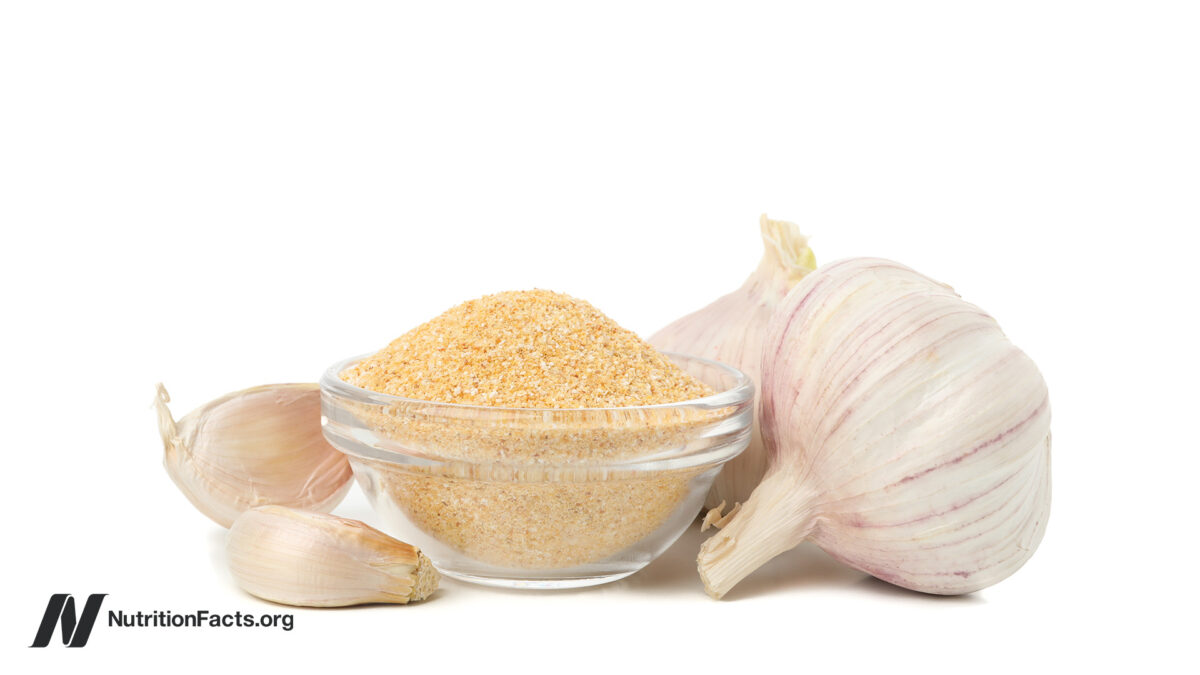The Pros of Garlic Powder for Heart Disease
See what a penny a day’s worth of garlic powder can do. In ancient Greece, “the Art of Medicine was divided into three parts”: cures […]

See what a penny a day’s worth of garlic powder can do.
In ancient Greece, “the Art of Medicine was divided into three parts”: cures through diet, cures through drugs, and cures through surgery. Garlic, Hippocrates wrote, was one such medicinal food, but that was to treat a nonexistent entity called “displacement of the womb,” so ancient wisdom can only go so far.
Those who eat more than a clove of garlic a day do seem to have better artery function than those who eat less than that, but you don’t know if it’s cause-and-effect until you put it to the test.
As I discuss in my video Benefits of Garlic Powder for Heart Disease, heart disease patients were randomized to receive either garlic powder or placebo tablets two times a day for three months. Those lucky enough to be in the garlic group got a significant boost in their artery function—a 50 percent increase in function from taking only 800 mg of garlic powder a day. That’s just a quarter teaspoon of garlic powder. A 50 percent increase in artery function for less than a penny daily!
If regular, plain old garlic powder can do that, what about those fancy Kyolic® aged garlic extract supplements? They can be 30 times more expensive and don’t work at all. After four weeks, there was zero significant improvement. It’s hard to improve on Mother Nature.
Garlic powder can improve the function of our arteries, but what about the structure of our arteries? Dozens of studies on garlic all compiled together show that garlic can reduce cholesterol levels in the blood by more than 16 points. So, might garlic powder actually be able to slow the progression of atherosclerosis? Researchers studied a garlic powder tablet versus a placebo for three months. As you can see below and at 1:42 in my video, the placebo group got worse, which is what tends to happen. Eat the same artery-clogging diet, and your arteries continue to clog. However, the progression of the disease appeared to slow and even stall in the garlic group.

Of course, it would be nice to see the thickening of the artery wall reverse, but, for that, one might have to add more plants than just garlic to one’s diet. Still, though, that same quarter teaspoon of a simple spice available everywhere may be considered as an adjunct treatment for atherosclerosis, the number one killer of both men and women in the United States and around much of the world.
What about garlic for high blood pressure? A systematic review and meta-analysis of randomized controlled trials “demonstrated that garlic has a statistically significant and clinically meaningful effect” on both systolic and diastolic blood pressures, reducing the top number by nearly seven and the bottom number by about five. That may not sound like a lot, but reducing diastolic blood pressure (the bottom number) by five points can reduce the risk of stroke by about a third and heart disease by 25 percent, as you can see in the graph below and at 2:38 in my video.

“Plant-based medicine provides beneficial effects, alongside with only minimal or no complications”—that is, little or no side effects—“and compared to other medicine are relatively cost-effective.” I’d say so, at as little as a penny per day.
What else can garlic do? See related posts below.
Here’s a tasty, garlicky recipe from The How Not to Die Cookbook: Garlic Caesar Salad Dressing.
Of course, the best way to treat heart disease is to simply get rid of it by treating the underlying cause. See How Not to Die from Heart Disease.

 AbJimroe
AbJimroe 






























